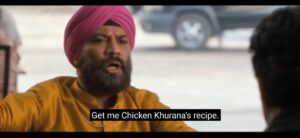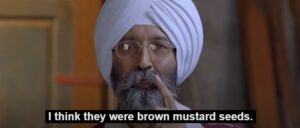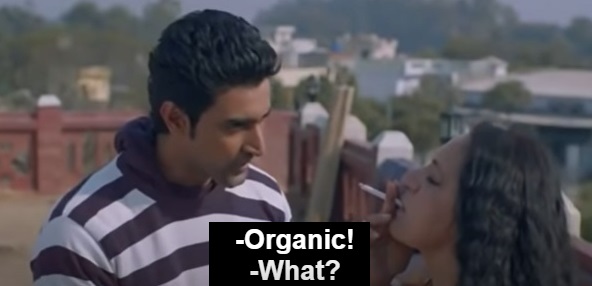flIPstaan: UNRAVELLING THE ‘TRADE SECRET’ CONUNDRUM WITH ‘CHICKEN KHURANA’

SEASON 1
EPISODE 2 – 26th July, 2020

STARTER
In the 2012 film ‘Luv Shuv Tey Chicken Khurana’, a character named ‘Omi’ (living in London) under debt informs his creditor that he will clear the loan imposed upon him as his grandfather has a renowned restaurant in Punjab by the name ‘Chicken Khurana’.


However, when he arrives in Punjab, he finds out that his grandfather had lost his memory due to old age.

He further comes to realize that the concerned restaurant is closed as no one knew how to make the immensely successful signature dish ‘Chicken Khurana’ apart from the grandfather. It is revealed that as the grandfather had not shared the recipe and had also lost his memory, the profits of the restaurant dwindled slowly on account of the non-availability of ‘Chicken Khurana’. Resultantly, the restaurant had to be closed.


Now, to clear off his debts ‘Omi’ had to wait for his grandfather to recover from his illness. This is for the reason that without the grandfather, there is no recipe and without the recipe there is no money. Thus, we realise that the recipe of ‘Chicken Khurana’ had a commercial value for the restaurant as it ensured economic returns.
MAIN COURSE
Ingredients of Trade Secrets
‘Trade Secret’ is a form of intellectual property. From what we just mentioned, we find that the first Ingredient of a ‘Trade Secret’ is, information that is of ‘Commercial Value’. However, does all information having ‘commercial value’ constitute a ‘trade secret’?
The movie answers this question in another scene wherein a competitor offers ‘Omi’, Rupees One Crore for the Restaurant, contingent upon disclosure of the signature recipe, ‘Chicken Khurana’.


Therefore, we see that the competitor with all his resources does not have a recipe for ‘Chicken Khurana’. Thus, the reason why the information in question is a trade secret and not merely information of ‘commercial value’ is because the same is ‘Secret’. It is not known to the public.
Thus, the second ingredient of ‘Trade Secret’ is ‘Secret Information’. Once the trade secret is out, it loses its protected status and anyone can exploit it.[1]Thus, a trade secret has to be ‘confidential information’ having economic value/business value/commercial value.[2] Otherwise it will either be only a mere secret of no value or valuable but not protectable as a ‘trade secret’.
The information should be secret to the persons in the circle that normally deal with the kind of information, i.e., the trade circle. Otherwise, the information would just be called ‘secret’ and not ‘trade secret’. Thus, the third ingredient is ‘Secret to members of trade’. No one (except grandfather), including competitors, in the trade knew the recipe of ‘Chicken Khurana‘. Thus, recipe of ‘Chicken Khurana‘ was secret to members of the trade also.
The last ingredient of ‘trade secret’ is, that the person lawfully in control of the such secret informationm should have taken reasonable steps under the relevant circumstances, to keep it secret.
In case of ‘Chicken Khurana’, only one person knew the recipe, Omi’s grandfather. Thus, the information of constituents or method of ‘Chicken Khurana’ was a ‘Trade Secret’.

The above mentioned ingredients of the right to ‘trade secret’ are universal and are recognized in understanding/definition of ‘Trade Secrets’ under TRIPS[3], United States’ Uniform Trade Secrets Act, 1979[4] and ‘European Union Directive on the protection of undisclosed know-how and business information (trade secrets) against their unlawful acquisition, use and disclosure’.[5] The subject matter in TRIPS and EU Directive is identical.
A ‘trade secret’ need not be only a recipe. Perusal of the definitions which are either minimum standards under TRIPS or provided statutorily under various laws have been worded to give them a liberal interpretation so that a vast protection can be given to ‘trade secrets’. In case of United States of America, we see a very elaborate consideration of the subject of ‘trade secrets’ which includes formula, pattern, compilation, program, device, method, technique, or process.
Further ‘trade secrets’ have been observed in United States to contain contracts, [6] marketing strategies,[7] pricing data[8] and salaries.[9]
It can be said that any confidential business information which provides an enterprise a competitive edge and is unknown to others may be protected as a ‘trade secret’.[10] ‘Trade secrets’ encompass both technical information, such as information concerning manufacturing processes, pharmaceutical test data, designs and drawings of computer programs and commercial information.[11] It is further pertinent to mention that a trade secret may be also made up of a combination of elements, each of which by itself is in the public domain.[12]
Specifically recognised ‘not being readily ascertainable’ dimension
Apart from the above common ingredients, United States’ Uniform Trade Secrets Act (Supra) gives another dimension to ‘Ingredients of Trade Secret’, i.e. the ‘trade secret’ should not be ‘readily ascertainable by proper means’. This movie, gives us certain guiding light in determining what cannot be readily ascertainable by proper means.
Subsequently, in the film the grandfather dies and so does the prospect of getting signature recipe of ‘Chicken Khurana‘ from him.

Now, the only option Omi is left with, is to keep trying and testing various ingredients in order to make ‘Chicken Khurana’. ‘Omi’ miserably fails in his exploits.


Then, he approaches multiple old customers of the restaurants to ask them if they know what the secret ingredients in ‘Chicken Khurana’ were. He gets multiple answers but none of them turns out to be correct.








Thus, we see that the recipe of ‘Chicken Khurana’ is not ‘readily ascertainable’ and hence constitutes a ‘trade secret’ (provided other ingredients match). Though, USA specifically provides for ‘readily ascertainable’ requirement. In our view that should be applicable across jurisdictions because if the secret is ‘readily ascertainable’ it should not be protected.
In India, the recognition of protecting only those information as ‘trade secrets ‘which are not ‘readily ascertainable’ appears to have been discussed in Star India Pvt. Ltd. v. Laxmiraj Seetharam Nayak.[13] In this case, protection was not extended to information which does not require any special effort to be known. Thus, holding them beyond the realm of trade secrets. The said decision has been dealt subsequently.
Prohibition against unauthorised use and transfer of rights in ‘trade secrets’
It is well-known that any unauthorized acquisition, use or disclosure of trade secrets in a manner contrary to honest commercial practices is considered unfair trade practice and violation of trade secret rights. However, a trade secret, if obtained by a party through the process of reverse engineering is not a violation of ‘trade secret’ rights.[14] Further, a ‘trade secret’ like any other property is capable of being licensed or assigned as we see in the case of the film in question, where the recipe of ‘Chicken Khurana’ was sought to be sold to a competitor.

India and Trade Secrets
India does not have a specific legislation to protect ‘trade secret’. The same is protected in India on basis of principles of equity, and common law action of breach of confidence and contractual obligation.[15] India recognises the standard ingredients of the subject matter under ‘trade secret’. In Indian Farmers Fertilizer v. Commissioner of Central Excise[16] ‘trade secret’ was stated to be as:
“A trade secret is such sort of information, which is not generally known to the relevant portion of the public, that confers some sort of economic benefit on its holder and which is the subject of reasonable efforts to maintain its secrecy.”
Some of the judgments from various courts in India and the judicial propositions on ‘trade secrets’ covered by these judgments, are provided herein below:
Contract is not a Necessity
In John Richard Brady and Ors. v. Chemical Process Equipments Pvt. Ltd. and Ors.[17] it was observed that to exercise a right of protection of ‘trade secret’ there need not be any contract between the Plaintiff (complainant) and the Defendant (accused) and what is required is an implied understanding that the confidential information has been shared in confidence.
Tests when Information is Confidential
In the case of Mr. Anil Gupta and Anr. v. Kunal Dasgupta and Ors.[18]the issue was whether the Plaintiff’s concept note of a reality show for match-making shared with the Defendant constituted a confidential information. It was held that if an idea/concept is developed to a stage when it demonstrates that it has some attractiveness and could be realized as an actuality, the same is protectable. The Defendants further argued that the information was also shared with other channels and hence is not a secret. The said contention was also rejected on the ground that the fact that the concept note was shared with other broadcasters, does not give Defendants to treat the same as non-confidential.
In Star India Pvt. Ltd. (supra) the Hon’ble High Court of Bombay held that an information that does not require any special effort to gather, is not a trade secret. The Court further held that every opinion or general knowledge of facts cannot constitute a ‘trade secret’. The Hon’ble Court excluded business dealings of a party with its advertisers and rates of the advertisements from ‘trade secret’ protection. The Hon’ble Court made a very interesting observation in the present matter that mere use of the words ‘strategies’, ‘policy decisions’ or ‘crucial policies’ repeatedly does not give an information a character of ‘trade secret’.
Further Exclusions from Trade Secrets
Similarly, Courts have excluded any business acumen or manner of dealing with customers, learnt by an employee on account of his/her employment[19] as well as database/details of clients/customers[20] from the protection of trade secret. Apart from the same ‘strategic business plans’, ‘square footage of construction’, ‘capital expenditure’ or ‘revenue budgets’ have been held to be information of non-confidential nature.[21]
Access as a Condition
Another important aspect considered by the Courts for purpose of grant of relief for violation of trade secrets is, the fact that whether the Defendant had access to the secret information.[22]
Ingredients of Violation
In Emergent Genetics India Pvt. Ltd. v. Shailendra Shivam and Ors.,[23] after following the English decision in Coco v. A.N. Clark (Engineers) Ltd.[24]the Hon’ble High Court of Delhi found the following factors to be essential for maintaining case for violation of ‘trade secret’:
“(1) the information itself must have the necessary quality of confidence about it;
(2) that information must have been imparted in circumstances imparting an obligation of confidence;
(3) there must be an unauthorized use of that information to the detriment of the party communicating it.”
The Plaintiff has to take steps to guard the information. Otherwise, the Information would not constitute trade secret.[25]
Specific Pleadings and Disclosures in Plaint
The pleadings in matters of violation of ‘confidential information’ should clearly provide for the nature and quality of the information as the same is crucial to the matter.[26] Further, In Ritika Private Limited v. Biba Apparels Pvt. Ltd.[27]the Hon’ble Court observed that it is necessary that Plaintiff provides for specific trade secrets not a general pleading on trade secrets as a general order cannot be passed against a Defendant. The Hon’ble Court was of the further view that that the Plaintiff in such cases has to disclose as to how the impugned ‘trade secrets’ are in the ownership of the Plaintiff, and only thereafter the court can consider the grant of any injunction order on the basis of specified trade secrets. It is also essential that the Plaintiff pleads in such cases that the Defendant was privy to such ‘trade secret’/’confidential information’.[28]
Avoidance of Creation of Extra-Statutory Monopoly
Lastly, in a recent decision, despite a know-how agreement between the parties did not entertain the plea of the Plaintiff towards ‘trade secret’ violation as the Delhi High Court was of the view that the information in question was covered by a Patent which had expired, any restriction on the Defendant on the basis of trade secret would amount to judicial creation of an extra-statutory monopoly for perpetuity in the invention, in contrast to the scheme of Patent Act, 1970. [29]
DESSERT
Now, coming back to the film, ‘Luv Shuv Tey Chicken Khurana’. When ‘Omi’ gave up the idea of ever knowing the secret of the recipe, he had a stroke of luck in his favour. He shares a powder with his relative which she smokes up.

Accidentally, the stuffed cigarette falls in a dish of brinjal.

The family members catch the distinct fragrance of ‘Chicken Khurana’ and ‘Omi’ discovers that it was Opium that was his grandfather’s secret ingredient in preparing ‘Chicken Khurana‘.
Thus, ‘Omi’ is able to revive his business and does not sell it to his grandfather’s competitor.
As far as ‘trade secret’ is concerned, we see that it is a unique intellectual property which has its own set of advantages and disadvantages. It can be protected perpetually, but has to be zealously guarded. It can be easily violated with no remedy for the Plaintiff in case of lack of diligence on part of the Plaintiff or in cases of reverse engineering. Thankfully, the test is ‘reasonable efforts’ to maintain the ‘trade secret’ on part of the trade secret owner. Further, an innocently created product which might have somebody else’s trade secret is not considered a violation. Protection of confidential information is a standard clause in employment agreements under the heading ‘Non-Disclosure’. Sometimes, a separate agreement is also entered into. It is advisable that such confidentiality agreements should be entered with vendors, licensees and directors/board members of the organization to protect the ‘trade secret’ vociferously. Entities should maintain adequate documentation in respect of any transaction/communication involving the ‘trade secret’.
In the event, suits are to be filed in respect of violation of trade secrets, the plaint should have specific details as to nature and detail of the relevant ‘trade secret’, ownership of the ‘trade secret’ and access of the Defendant. The plaint should also contain averments as to what efforts have been taken by the Plaintiff to protect the ‘trade secret’. Generally, ‘confidential information’ is shared with a ‘claim of confidentiality’.
[1] Lockridge v. Tweco Prods., Inc., 497 P.2d 131, 134 (Kan. 1972)
[2] Navigators Logistics Ltd. vs. Kashif Qureshi and Ors.; 2018(76) PTC 564 (Del)
[3] Art. 39.2 – Natural and legal persons shall have the possibility of preventing information lawfully within their control from being disclosed to, acquired by, or used by others without their consent in a manner contrary to honest commercial practices so long as such information:
(a) is secret in the sense that it is not, as a body or in the precise configuration and assembly of its components, generally known among or readily accessible to persons within the circles that normally deal with the kind of information in question;
(b) has commercial value because it is secret; and
(c) has been subject to reasonable steps under the circumstances, by the person lawfully in control of the information, to keep it secret.
[4] Sec. 1 – Information, including a formula, pattern, compilation, program, device, method, technique, or process, that: (i) derives independent economic value, actual or potential, from not being generally known to, and not being readily ascertainable by proper means by, other persons who can obtain economic value from its disclosure or use, and (ii) is the subject of efforts that are reasonable under the circumstances to maintain its secrecy.
[5] Art. 2 – Definitions For the purposes of this Directive, the following definitions apply: (1) ‘trade secret’ means information which meets all of the following requirements: (a) it is secret in the sense that it is not, as a body or in the precise configuration and assembly of its components, generally known among or readily accessible to persons within the circles that normally deal with the kind of information in question; (b) it has commercial value because it is secret; (c) it has been subject to reasonable steps under the circumstances, by the person lawfully in control of the information, to keep it secret.
[6] ConAgra, Inc. v. Tyson Foods, Inc., 30 S.W.3d 725, 728-30 (Ark. 2000)
[7] PepsiCo, Inc. v. Redmond, 54 F.3d 1262, 1265-70 (7th Cir. 1995)
[8] McFarland v. Brier, No. 96-1007, 1998 WL 269223
[9] Tom C. Lin, Executive Trade Secrets, 87 Notre Dame L. Rev. 911 (2013). available at: http://scholarship.law.nd.edu/ndlr/vol87/iss3/1
[10] Trade Secrets, available at: https://www.wipo.int/tradesecrets/en/
[11] Id.
[12] Id.
[13] 2003 SCC OnLine Bom 27
[14] DVD Copy Control Ass’n v. Bunner, 116 Cal. Rptr. 3d 185, 194 (Ct. App. 2004)
[15] Zafar Mahfood Rahmani & Faizanur Rahman, Intellection of Trade Secret and Innovation Laws in India, 16(4), JIPR, pg 341-350 at 345 (July 2011),
[16] 2007 (116) ECC 95
[17] AIR 1987 Delhi 372
[18] 97 (2002) DLT 257
[19] Ambiance India (Private) Ltd. v. Naveen Jain, 2005 SCC OnLine Del 367
[20] American Express Bank Ltd. v. Priya Puri, 2006 SCC OnLine Del 638
[21] Bombay Dyeing and Manufacturing Co. Ltd. v. Mehar Karan Singh, 2010 SCC OnLine Bom 1243
[22] Control Print (India) Limited v. Sanjay Sribastab and Ors., (2006) 2 CAL LT 145(HC)
[23] 2011 (47) PTC 494
[24] (1969) R.P.C. 41
[25] Supra note 21
[26] Supra note 23
[27] 230(2016)DLT109
[28] Navigators Logistics Ltd. vs. Kashif Qureshi and Ors., MANU/DE/3355/2018
[29] Sungro Seeds Ltd. vs. S.K. Tripathi and Ors., MANU/DE/1055/2020
Co-researcher: Mr. Abhishek Sharma, UILS, Chandigarh University
Images from the film ‘Luv Shuv Tey Chicken Khurana’, Anurag Kashyap Films, JAR Pictures and UTV Spotboy, 2012
